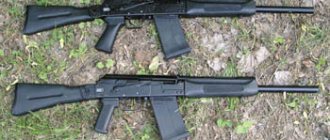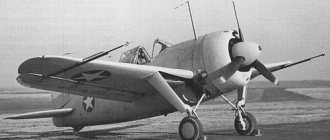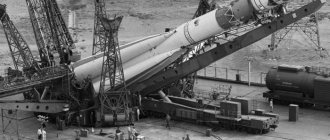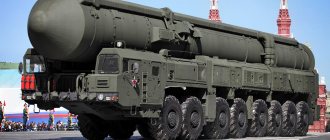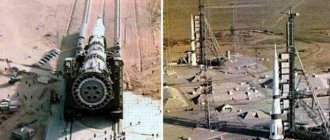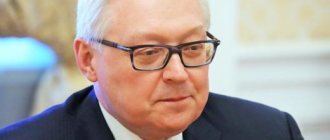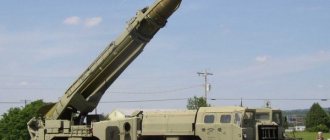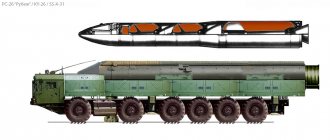Author: zaCCCPanec
11 November 2022 06:42
Tags: Military review R-1 (8A11 Pobeda) history of the Strategic Missile Forces
4876
17
The strategic missile forces are armed with unique complexes with the highest characteristics, capable of solving particularly important tasks. Their appearance became possible thanks to a long program of research and the creation of new projects with certain qualities. The first real step towards modern ballistic missiles made by Soviet industry was the R-1 product, also known as 8A11 and Pobeda.
0
See all photos in the gallery
R-1 rocket during preparation for launch.
The appearance of the R-1 missile was preceded by more than interesting events related to the study of trophies and developments of the destroyed enemy. During the Great Patriotic War, the Soviet command learned about the emergence of a new weapon in Germany - the A-4 / V-2 ballistic missile. Such weapons were of great interest to the USSR and its allies, and therefore a real hunt began for them. After the victory over Germany, the Coalition countries were able to search military enterprises and find the necessary documents, products, etc.
×
History of creation
The origins of the creation of the first Soviet ballistic missile R-1 lie with the German analogue of the V-2, which was actively used in 1944-45. for shelling the territory of Great Britain. A few months after the cessation of hostilities, a search began for employees of the enterprises that produced V-2, as well as finished samples.
The Soviet commission, called the “Vystrel” special group, was headed by S.P. Korolev. A lengthy search for a complete copy ended in vain, so the idea of restoring the rocket from the found debris and components arose.
At the same time, the zones of occupation of Germany were clarified, as a result of which the Thuringia region, where V-2 production plants were previously located, was transferred to the USSR. But American troops managed to remove all equipment and technical documentation, as well as all leading specialists.
This is exactly how Wernher von Braun came to the United States, who later became the “father” of the American space program. Soviet specialists, having examined the enterprises, found only fragments of missiles, for which there was no technical or drawing documentation.
In the spring of 1946, the Vystrel team was reorganized into 2 institutes, which were tasked with creating a Soviet copy of the V-2.
To speed up the progress of work, German specialists were widely recruited and brought from Germany. The bulk of the design work was carried out at NII-88, which was located in Kaliningrad near Moscow (now Korolev). Already in mid-autumn 1946, test launches of assembled and restored V-2s began to be carried out at the Kapustin Yar test site.
The first prototypes of the Soviet copy were assembled by the fall of 1948.
Since Soviet designers realized the futility of copying a German rocket of an outdated design, they began to work in advance on promising designs for weapons with a detachable warhead. To test separation mechanisms and test new components, a modification of the R-1A rocket was created, which was ready for flights in the late spring of 1949.
The R-1A design featured a load-bearing fuel tank, while the oxygen tank remained a separate module.
The tested solutions were later used in the R-2 rocket, and the built R-1A copies were used to study the upper layers of the atmosphere. A total of 6 launches were carried out along ballistic and vertical trajectories.
Later, the R-1B version appeared, which was equipped with a lowered sealed capsule with animals. Tests were carried out in the summer of 1951. The R-1B version with a special parachute unit was tested at the same time. The R-1D modification was used to test spacesuits that were put on experimental dogs.
Additionally, studies were carried out on the mechanism of propagation of ultra-long waves in a rarefied atmosphere. In 1955-56. The latest version of the P-1E was submitted for testing, which tested the possibility of accelerating the detachable part with powder accelerators. The R-1M version was a deep modernization of the R-1 missile; a series of test launches were carried out in 1955. But the project did not receive development due to the emergence of more promising models of missile weapons.
Pragmatic romantic
Chief Designer - that's what they called him in the newspapers. Colleagues called him SP behind his back - this was considered the highest degree of respect in rocket circles. Regalia was not a priority for Korolev. He did not accept the status of “general” and did not dream of the Nobel Prize, which he could not receive because he remained secret. The chief designer was quite happy with his own small “kingdom” - in Podlipki near Moscow, where rocket scientists from top scientists to workers settled. A research and production center was located there, in which Korolev’s word was worth its weight in gold. Scientists are ambitious people, and it is not easy to become an undisputed leader among them. And there were legends about Korolev. And about how he placed a bugler at the launch of the first satellite, and about how he resolved the dispute about the surface of the Moon - is it hard or like a pillow. There was no exact information then. And the chief designer took a sheet of paper and wrote large: “The lunar surface is hard. Korolev." At one's own risk.
Photo: RIA Novosti
Sergei Pavlovich Korolev with a dog before launching it into space
Cosmonaut and scientist Konstantin Feoktistov wrote about the chief designer: “The most characteristic feature of Korolev is his enormous energy. He knew how to infect those around him with this energy. He was a very determined man, often quite stern. Korolev is a fusion of rationalism and dreaminess.” Many people remember the stern disposition of the Chief: it happened that papers were scattered throughout his office. But when it came to the most important decisions, he patiently listened to all opinions.
Take off, weapons: what kind of rocket did Russia test in space?
The Ministry of Defense emphasizes that the debris of the destroyed satellite does not pose any threat to the ISS.
Rocket launches
The first successful launch of the R-1 rocket took place in the second half of September 1948, i.e. just 2.5 years after the start of work on the facility. The first batch, intended for test launches, consisted of 12 products. German telemetry equipment was used in the design of some of the missiles, but the Soviet equivalent was already used on 10 copies.
Within a month, one of the R-1 missiles reached the required flight range of 300 km.
At the same time, test flights of the object were carried out with various scientific and diagnostic equipment. The last missile launches of the first test series were carried out at night.
Representatives of the USSR armed forces who were present at the test launches noted the shortcomings, and then sought to promptly eliminate the identified defects. The main problem was defects in the R-1 jet engine, which did not return to normal operation. The reason was the pyrotechnic fuel ignition system, which had to be modernized.
In mid-autumn 1949, a second batch of 20 R-1 missiles arrived for testing, which showed a significant improvement in reliability. But the overall assessment of the weapon from customers was negative. The military insisted on further improvement of weapons.
Despite all the problems, the R-1 missile was put into service in the late autumn of 1950. Serial production was launched on the territory of the Dnepropetrovsk Automotive and Tractor Plant, which received code number 586. An interesting fact is that in parallel with the missiles, tractors were produced that were branded YuMZ (short for Yuzhny Machine-Building Plant).
Despite serial production, testing of the R-1 rocket continued. At the beginning of 1951, the third batch was submitted for testing, which showed an improvement in hit accuracy. During these test launches, repeated spontaneous explosions of warheads were noted, and the Germans also faced the same problem at one time.
During the descent flight, intense heating of the warhead shell and TNT charge occurred, which began to evaporate. Under certain conditions, the vapor pressure exceeded the safety margin of the sealed housing, which burst. In this case, dynamic loads arose that inevitably reached the inertial fuse.
The device perceived this as a signal to action and detonated the R-1 charge. The employees of the Kapustin Yar test site managed to unravel the reason only in 1954, while German specialists were unable to cope with this task.
In total, during the testing of the R-1 rocket, at least 296 engine starts were performed.
79 missiles took off into the air over the Kapustin Yar test site. In addition, an unknown number of German V-2s were launched, which were classified according to Soviet documentation as A-4.
Modern stage
Currently, the most powerful launch vehicles are the domestically produced Proton-M, the European Ariane-5, and the American Delta-IV Heavy. The launch of a rocket of this type makes it possible to launch a payload weighing up to 25 tons into orbit (200 km in altitude). Such devices can deliver approximately 6-10 tons to geointermediate orbit and 3-6 tons to geostationary orbit.
The Proton launch vehicles deserve special attention, as they played a significant role in space exploration. They were used to implement various manned programs, incl. to send modules to the Mir orbital station. With its help, Zvezda and Zarya, the most important blocks of the ISS, were delivered into space. Despite the fact that not all useful launches of such rockets were successful, Proton still remains the most popular launch vehicle: approximately 10-12 launches are carried out every year.
Design
Structurally, the R-1 missile consists of a head section in which the warhead and control units are located, an additional instrument compartment, separate tanks for fuel and oxidizer, and a tail section in which the engine is located. The rocket body is built using aviation technology - from frames and connecting stringers made of various grades of steel. The outside of the frame is covered with steel sheets of varying thicknesses, which are secured with rivets.
For access to the equipment there are numerous hatches closed with covers. Tanks for fuel components are made of aluminum sheet, installed inside the frame and do not play a load-bearing role. The warhead is rigidly integrated into the R-1 design and does not separate when approaching the target.
The warhead was equipped with an explosive charge weighing 800 kg, which did not provide a large affected area. When a rocket fell into an area with dense buildings, buildings within a radius of no more than 25 m from the point of explosion were destroyed.
For the R-1 flight, a single-chamber RD-100 engine was used, which used ethyl alcohol diluted with water as fuel (ratio 3-1).
The use of water made it possible to reduce the temperature of the combustion chamber and nozzle, but at the same time worsened engine thrust. Liquid oxygen acted as an oxidizing agent.
Both components were supplied by mechanical pumps driven by a steam-gas turbine, for which there was a separate fuel system. The steam gas was formed in a special reactor as a result of the decomposition of hydrogen peroxide under the influence of potassium permanganate. The supply of reagents to the R-1 reactor was carried out using a displacement process.
At the moment of start-up, a chemical reaction began, the resulting vapor-gas mixture spun the pumps, and fuel was supplied to the combustion chamber. A pyrotechnic device was used for the flash, later replaced by a liquid incendiary module. The R-1 engine was heavy, and its characteristics were far from ideal, even taking into account the design. But this was the first domestic rocket engine, the development of which made it possible to raise a generation of specialists in this field.
To orient the R-1 rocket in flight, there are 4 stabilizers located symmetrically in the tail section. To adjust the trajectory, rudders mounted on stabilizers are used. But to improve performance, additional control planes are used, located in the exhaust gas flow that flows out of the engine nozzle. The R-1 inertial control system ensured that the flight angle was maintained at the active distance; in addition, there was an automatic flight range.
Due to the use of imperfect components, the electronic units weighed more than 200 kg. At the same time, the equipment did not correct the lateral drift of the missile in any way, so the weapon had a dispersion of 1500 m with a flight range of 300 km.
The disadvantage of the R-1 was the large amount of equipment required for refueling and launch. More than 20 units of specialized transport were required for 1 missile. Before launch, the warhead was mounted on the weapon, after which the weapon was transported on a special trawl to the launch site. After bringing the hull into a vertical position, the control systems were tested, and the target coordinates were set, after which refueling and oxidizer began.
At the same time, the reagents were loaded into the R-1 steam-gas reactor. The electronic equipment was configured from a special platform located around the warhead. Part of the combat crew adjusted the engine components and pumping station, and also installed the starting fuse in the combustion chamber. The launch command was given remotely from a special vehicle with an armored cabin.
The total time spent on launch reached 8 hours; in exceptional cases, the trained calculation was completed within 6 hours.
Moreover, the fueled R-1 rocket had to be launched, since draining the fuel took even more time and was associated with the risk of fire and explosion.
According to the memoirs of academician B.E. Chertok, the use of ethyl alcohol as fuel, coupled with the low accuracy of the weapon, caused a storm of indignation among the Soviet generals. One of the generals directly stated that distributing the volume of alcohol available in one R-1 to the units entrusted to him would lead to greater results than launching a rocket. After which the military leader added that the missile would not yet hit the city, which his subordinates, “warmed up” by alcohol vapor, would have successfully occupied on the move.
Rocket engine and quick start
A powder or solid propellant rocket engine (solid propellant rocket motor) saved time at launch: the rocket did not need to be refueled before launch. But a liquid propellant rocket engine (LPRE) made the rocket cheaper and threw it further than a solid propellant rocket engine with the same mass of fuel. The advent of liquid-propellant rockets with ampoule fuel storage has made it possible to reduce the launch time of ICBMs with liquid propellant engines to 3–5 minutes - the same as for rockets with solid propellant rocket engines. Fuel and oxidizer began to be stored in sealed “ampoules” tanks, which were filled at the ICBM manufacturing plant. Nowadays, both solid propellant rocket engines and liquid propellant rocket engines with ampoule storage are used.
In the 1960s They began to use mortar launch : ICBMs, like a mine, were thrown out by a powder pressure accumulator (PAD) - a charge placed in a transport-launch container. The rocket took off without wasting fuel, and only fired its engines during flight - this made it possible to reduce the amount of fuel on board, making the rocket lighter.
Performance characteristics of the missile
Compared to the German original, the R-1 rocket has an elongated body and a slightly increased fuel supply. It should be borne in mind that the concept of fuel supply for V-2 and P-1 means fuel for a jet engine, a steam-gas turbine, as well as a supply of compressed air. Due to the use of enlarged tanks and design improvements (in particular, an increase in engine thrust by 8%), the weight of the weapon also increased slightly.
At the same time, the guaranteed flight range of the R-1 is 50 km less, the limiting point of the trajectory is located 30 km higher.
| R-1 | R-1A | V-2 | Convair RTV-A-2 | |
| Weight at start, kg | 13400 | 13910 | 12500 | 1860 |
| Thrust at takeoff, tf | 27 | 27 | 25 | n.d. |
| Engine operating time, sec | 65 | 65 | 71 | n.d. |
| Fuel weight, kg | 9440 | 9440 | 9106 | n.d. |
| Weight of warhead, kg | 1000 | 800 | 1000 | n.d. |
| Length, mm | 14600 | 14960 | 14030 | 9630 |
| Case diameter, mm | 1650 | 1650 | 1650 | 760 |
| Flight altitude, km | 100 | 100 | 70 | n.d. |
The Americans, despite bringing V-2 author Wernher von Braun to the United States, showed no interest in long-range ballistic weapons. In 1945, development of several projects began, including the Convair RTV-A-2. But already in 1947, work was curtailed for almost a decade. The American model, created without the influence of the V-2, has noticeably smaller dimensions and weight. The weight reduction was achieved through the use of a load-bearing body, which subsequently began to be used on all rockets.
Military service and trace in history
The R-1 missile entered service with units of the Soviet Army in the fall of 1950, receiving an index according to the GRAU card index 8A11 and the code name “Volga” object. The weapon was used by special forces brigades, according to NATO classification it had the designation SS-1 “Scunner”.
The doctrine of the use of missile weapons provided for striking large military and industrial facilities, as well as points of strategic importance. The estimated fire performance of one brigade was up to 36 R-1 launches per day. A number of P-1s were used during nuclear weapons exercises at the Totsky training ground in 1953.
But already in 1956, the P-1 began to be replaced by new types of weapons. The short service life of the weapon was due to design flaws, which were gradually eliminated in subsequent missile models. By the beginning of 1960, R-1s were no longer listed in the staffing table of the Soviet Army. Other countries of the socialist camp did not have weapons in their arsenal.
The total development time of the P-1 was, taking into account the German period of formation of the V-2, more than 16 years.
In this regard, the weapon is a record holder; not a single missile in the world required such efforts to create and eliminate “childhood diseases.” But it was the R-1 that allowed the USSR to make a technological breakthrough into a completely unknown field of technology.
The following systems were created in 6-7 years, and already in 1961 the Vostok rocket took to the skies with the first cosmonaut on board. Designed by S.P. Korolev’s R-7 carrier is still used today to launch spacecraft into near-Earth orbits. And few people remember that at the origins of this carrier is the unsightly R-1 rocket, which first took to the air in the fall of 1948.
